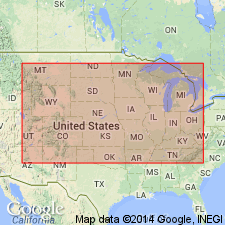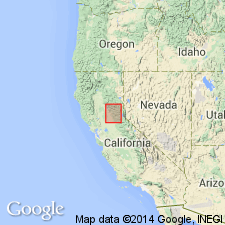
- Usage in publication:
-
- Delhi formation*
- Modifications:
-
- Original reference
- AAPG geologic province:
-
- Sierra Nevada province
Summary:
Delhi formation. Chiefly a peculiar dark-brown or black hard rock so fine-grained as to be almost flinty and rarely showing either stratification or schistosity. Often has chert-like appearance, but contains less silica than the normal chert. The peculiar petrographic character probably due to regional metamorphism. Very few lenticular limestone masses occur in it. In a few places the rock shows marked schistosity and resembles a dark siliceous clay shale. The formation corresponds to part of Calaveras formation. Overlies Cape Horn slate and underlies Clipper Gap formation. Age is Mississippian.
Typical exposures near Delhi Mine, Nevada Co., Colfax quadrangle, north-central CA.
Source: US geologic names lexicon (USGS Bull. 896, p. 594).

- Usage in publication:
-
- Delhi formation*
- Modifications:
-
- Overview
- AAPG geologic province:
-
- Sierra Nevada province
Summary:
Chart 5 (col. 15). Delhi formation. Shown on correlation chart above Cape Horn slate and below Clipper Gap formation. Age is Late Mississippian (Chesterian).
Source: US geologic names lexicon (USGS Bull. 1200, p. 1080); GNC index card files (USGS-Menlo).

- Usage in publication:
-
- Delhi Formation†
- Modifications:
-
- Abandoned
- AAPG geologic province:
-
- Sierra Nevada province
Summary:
†Delhi Formation abandoned. Rocks now included in undifferentiated chert and argillaceous member of Calaveras Formation.
Source: GNC index card files (USGS-Menlo).
For more information, please contact Nancy Stamm, Geologic Names Committee Secretary.
Asterisk (*) indicates published by U.S. Geological Survey authors.
"No current usage" (†) implies that a name has been abandoned or has fallen into disuse. Former usage and, if known, replacement name given in parentheses ( ).
Slash (/) indicates name conflicts with nomenclatural guidelines (CSN, 1933; ACSN, 1961, 1970; NACSN, 1983, 2005, 2021). May be explained within brackets ([ ]).

